
San Pietro in Vinculis is a Romanesque-style, Roman Catholic church in Pisa, region of Tuscany, Italy.

San Pietro in Vinculis is a Romanesque-style, Roman Catholic church in Pisa, region of Tuscany, Italy.
It was built by the Augustinians in 1072-1118 over a pre-existing edifice. The rectory was added a few years later.
The structure follows the Pisan Romanesque style established by Buscheto. It has a nave and two aisles with apses. The façade is articulated by pilaster strips, blind arches, oculi (small circular windows), lozenges and mullioned windows.
In the interior the intarsia pavement lies over a crypt with groin vaults and Roman capitals, perhaps the relic of an ancient market loggia later turned into a Christian temple. It houses a Roman sarcophagus, remains of frescoes and a Crucifix on panel from the 13th century. In the rectory are frescoes from the 13th and 15th centuries and 18th century stuccoes. The bell tower was in origin a civil tower (late 11th-early 12th century).
For years, the church kept a famous manuscript containing a digest of the Corpus Juris Civilis of Emperor Justinian I of the Eastern Roman Empire. The document had fallen into Pisan hands after the sack of Amalfi in 1137. After Pisa fell in 1406, the Florence the document was transferred to the latter city. [1]

Romanesque architecture is an architectural style of medieval Europe that was predominant in the 11th and 12th centuries. The style eventually developed into the Gothic style with the shape of the arches providing a simple distinction: the Romanesque is characterized by semicircular arches, while the Gothic is marked by the pointed arches. The Romanesque emerged nearly simultaneously in multiple countries ; its examples can be found across the continent, making it the first pan-European architectural style since Imperial Roman architecture. Similarly to Gothic, the name of the style was transferred onto the contemporary Romanesque art.

The Piazza dei Miracoli, formally known as Piazza del Duomo, is a walled 8.87-hectare (21.9-acre) compound in central Pisa, Tuscany, Italy, recognized as an important center of European medieval art and one of the finest architectural complexes in the world. It was all owned by the Catholic Church and is dominated by four great religious edifices: Pisa Cathedral, the Pisa Baptistery, the Leaning Tower of Pisa, and the Camposanto Monumentale. Partly paved and partly grassed, the Piazza dei Miracoli is also the site of the Ospedale Nuovo di Santo Spirito, which now houses the Sinopias Museum and the Cathedral Museum.

Assisi Cathedral, dedicated to San Rufino, is a major church in Assisi, Italy. This stately church in Umbrian Romanesque style was the third church built on the same site to contain the remains of bishop Rufinus of Assisi, martyred in the 3rd century. The construction was started in 1140 to the designs by Giovanni da Gubbio, as attested by the wall inscription visible inside the apse. He may be the same Giovanni who designed the rose-window on the façade of Santa Maria Maggiore in 1163.
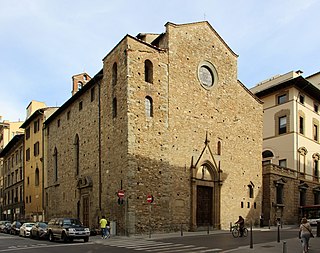
Santa Maria Maggiore di Firenze is a Romanesque and Gothic-style, Roman Catholic church in Florence, region of Tuscany, Italy. This is among the oldest extant churches in Florence.

Pisa Cathedral, officially the Primatial Metropolitan Cathedral of the Assumption of Mary, is a medieval Catholic cathedral dedicated to the Assumption of the Virgin Mary, in the Piazza dei Miracoli in Pisa, Italy, the oldest of the three structures in the plaza followed by the Pisa Baptistry and the Campanile known as the Leaning Tower of Pisa. The cathedral is a notable example of Romanesque architecture, in particular the style known as Pisan Romanesque. Consecrated in 1118, it is the seat of the Archbishop of Pisa. Construction began in 1063 and was completed in 1092. Additional enlargements and a new facade were built in the 12th century and the roof was replaced after damage from a fire in 1595.

San Frediano is a Romanesque-style Roman Catholic church in Pisa, Tuscany, Italy. It now functions as the official church of the University of Pisa.

San Piero a Grado is a church in Pisa, Tuscany, Italy, in the eponymous frazione 7 kilometres (4.3 mi) west of the city center. The church is located where once was a now disappeared port of the Pisan Republic, where, according to the legend, St. Peter landed in Italy from Antiochia in 44 AD.
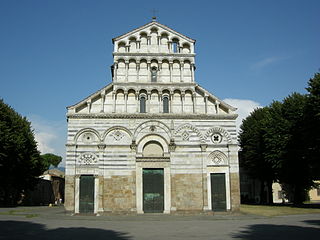
San Paolo a Ripa d'Arno is a Roman Catholic church in Pisa, region of Tuscany, Italy. It is a pre-eminent example of Tuscan Romanesque church architecture. The church is also locally known as Duomo vecchio.

San Sisto is a church in Pisa, Tuscany, Italy.

San Paolo all'Orto is a Romanesque-style, former Roman Catholic church in Pisa, region of Tuscany, Italy.
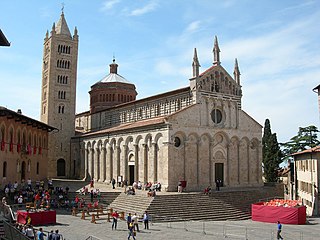
Massa Marittima Cathedral is a Roman Catholic cathedral in Massa Marittima, Tuscany, Italy, dedicated to Saint Cerbonius. Formerly the episcopal seat of the Diocese of Massa Marittima, it is now that of the Diocese of Massa Marittima-Piombino.

San Giovanni Fuoricivitas is a Romanesque religious church and adjacent buildings in Pistoia, Tuscany, central Italy. The adjective fuoricivitas refers to it location, outside of the first set of city walls, when it was founded during the era of Lombard rule in Italy.

Cagliari Cathedral is a Roman Catholic cathedral in Cagliari, Sardinia, Italy, dedicated to the Virgin Mary and to Saint Cecilia. It is the seat of the archbishop of Cagliari.
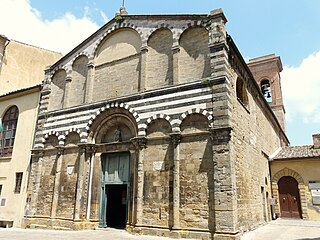
San Michele Arcangelo is a 13th-century Romanesque-style Roman Catholic church located on Via Guarnacci #6 in Volterra, province of Pisa, region of Tuscany, Italy. The church is across the street from the Medieval Palazzo Maffei-Guarnacci.

Santi Jacopo e Filippo or Santi Iacopo e Filippo is an ancient church found in Via San Michele degli Scalzi in Pisa, Italy.
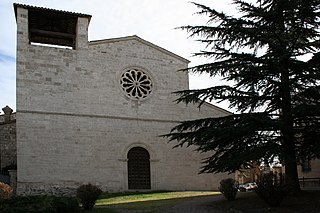
San Vittore is a Romanesque and Gothic-style, Roman Catholic church located in the town of Ascoli Piceno in the region of Marche, Italy.
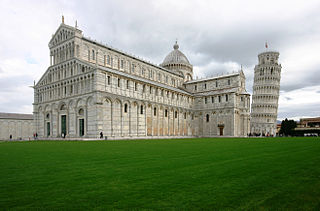
Pisan Romanesque style is a variant of the Romanesque architectural style that developed in Pisa at the end of the 10th century and which influenced a wide geographical area at the time when the city was a powerful maritime republic.

Santa Maria is the Roman Catholic, Romanesque-style church, located on Via Moricotti #2 in the town of Vicopisano in the province of Pisa, Tuscany, Italy.

The Pieve di San Verano is a Roman Catholic, Romanesque-style, formerly-rural parish church now located in on Piazza Popolo #1 in the historic center of Peccioli, province of Pisa, region of Tuscany, Italy. The church is dedicated to Veranus of Cavaillon.

Palazzo Gambacorti is a Gothic-style former aristocratic palace, located in Lungarno Gambacorti #1 corner with Piazza XX Settembre, near the spot the Ponte the Mezzo crosses over to the South bank of the Arno, in the historic center of Pisa, region of Tuscany, Italy. It is connected through the second floor of the white marble Loggia di Banchi, once the town archive. The palace is now houses the city council meetings in its Sala delle Baleari.